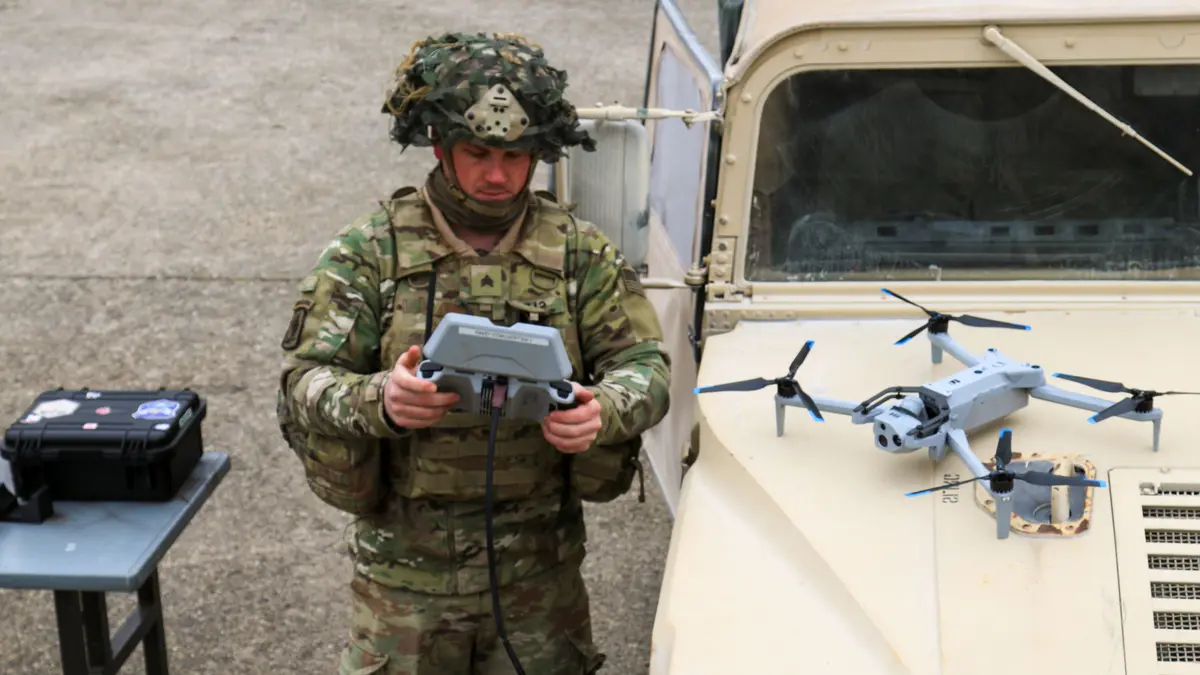To keep pace with the rapid development of drone warfare seen in Ukraine, the U.S. Department of Defense is conducting rigorous field testing of unmanned aerial systems designed to mirror the hostile battlefield environment. The effort, led by the Defense Innovation Unit (DIU), aims to accelerate the deployment of commercial drone technology to the frontlines.
Simulating Real-World Battlefield Conditions
In late June, during trials at a range near Fort Wainwright, Alaska, five drone developers — including startups and small companies — tested prototype platforms under simulated electronic warfare (EW) conditions. Operators faced GPS jamming, disrupted command-and-control links, and dense electronic clutter that mimicked conditions encountered in Ukrainian combat zones.
Initially, most systems struggled – losing flight paths, failing to lock onto targets, or suffering navigation errors as signal interference intensified. By the final day, several teams had successfully iterated through repeated field tests, demonstrating resilience and software adaptability.
DIU’s autonomy leader, Trent Emenaker, stressed the importance of embedded innovation: “If we’re going to be successful, we have to connect engineers with warfighters, and we have to be present in field testing. We always have to do that.”
- A U.S. Army soldier is preparing the Anduril Ghost X UAV, known for its low acoustic signature and modular design. It supports a variety of missions through five payload bays, including laser weapons or cruise missile tracking. The Ghost drone can also operate in swarms, relaying data to extend communication range. (U.S. Army photo by Staff Sgt. Lashik Patterson)
Learning from Ukraine’s Innovation Ecosystem
Ukraine’s drone warfare experience — including frontline units like the 3rd Assault Brigade and Unmanned Systems Forces — has set new standards in combat innovation. Ukrainian fighters routinely use FPV drones, autonomous grenade-droppers, and AI-enabled loitering munitions that have reshaped battlefield tactics.
The lessons go beyond technology: Ukrainian defense companies work directly with combat units, enabling rapid deployment of capabilities based on real-time iteration and frontline feedback. This model of agile procurement and battlefield-driven innovation has become a template for the Pentagon’s shift in strategy.
Operational Testing and Prototype Development
The Alaska Trial, part of DIU’s ongoing autonomy evaluation, falls under the Artemis program, which focuses on long-range, electronic warfare-resistant loitering munitions. These prototypes are expected to operate in conditions of GPS denial and disrupted communications, while remaining affordable and easily fielded at scale.
Several U.S. startups also participated: for example, Performance Drone Works (PDW), whose racing-derived quadcopters and AI-guided systems exemplify this commercial-to-military adaptation trend.
Along with this, the US has secured deals such as a $50 million contract with the Pentagon’s Oterion that will deliver 33,000 AI-powered “strike kits” to Ukraine, transforming commercial platforms into autonomous weapons systems capable of tracking targets up to 1 km away.

- US Army CW2 Chris Lehr launches a 3D-printed FPV drone with experimental electronic warfare technology during testing at the JMRC in Hohenfels, Germany, on April 11, 2025. Its parts are salvageable for reuse. (U.S. Army photo by Pfc. Brent Lee)
Strategic Implications and Future Directions
This shift in U.S. strategy marks a departure from legacy testing environments, which rarely replicate battlefield conditions. The long-standing lack of high-quality EW threats at training ranges and GPS jamming have limited the resiliency of U.S. systems—a problem that these tests aim to improve.
Defense officials emphasize that standard acquisition protocols should be adapted. Instead of lab-bench demonstrations, prototypes should be subjected to stressful conditions that reveal vulnerabilities, encourage rapid innovation, and align with operational timelines.
If successful, this approach could help the U.S. The Army could accelerate the regionalization of unmanned capabilities across units, which could align with broader modernization goals, including NATO’s Eastern Flank Deterrence Strategy.
Also Read: Turkey Secures $10 Billion Deal with Indonesia for 48 KAAN Fifth-Generation Fighter Jets
Conclusion
The U.S. military’s move to replicate battlefield conditions like those in Ukraine marks a strategic evolution in drone development and testing. By embedding commercial innovation in a harsh, competitive environment, the Pentagon seeks to address capability gaps exposed by Russia and other adversaries. As battle-tested systems move closer to deployment, the future of drone warfare may be defined not in laboratories, but under jamming skies and fragmented airspace.
Further Reading: Space Force General Declares U.S. Capable of Building Space-Based Missile Defense System
FAQs: Questions & Answers
Because real-world combat isn’t like a lab test. In areas like Ukraine, drones face GPS jamming, poor connectivity, and lots of electronic interference. Testing drones in these challenging conditions helps identify early problems like navigation glitches or control malfunctions so engineers can fix them before soldiers use them.
Yes. Many companies make off-the-shelf drones that can be upgraded with better software, cameras, or “strike kits.” This makes them affordable and quickly deployable. However, turning a hobby or delivery drone into a battlefield tool requires additional testing for security, jamming protection, and operational procedures.
Further Reading: Space Force General Declares U.S. Capable of Building Space-Based Missile Defense System








Leave a Reply